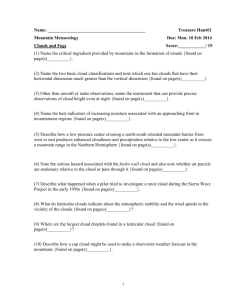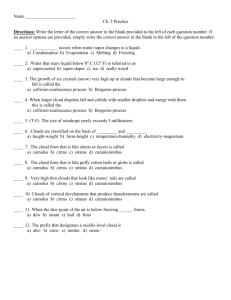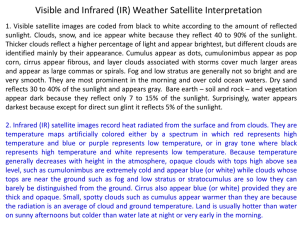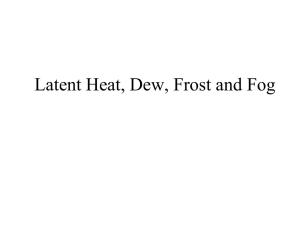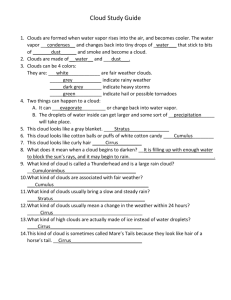Chapter 05
advertisement
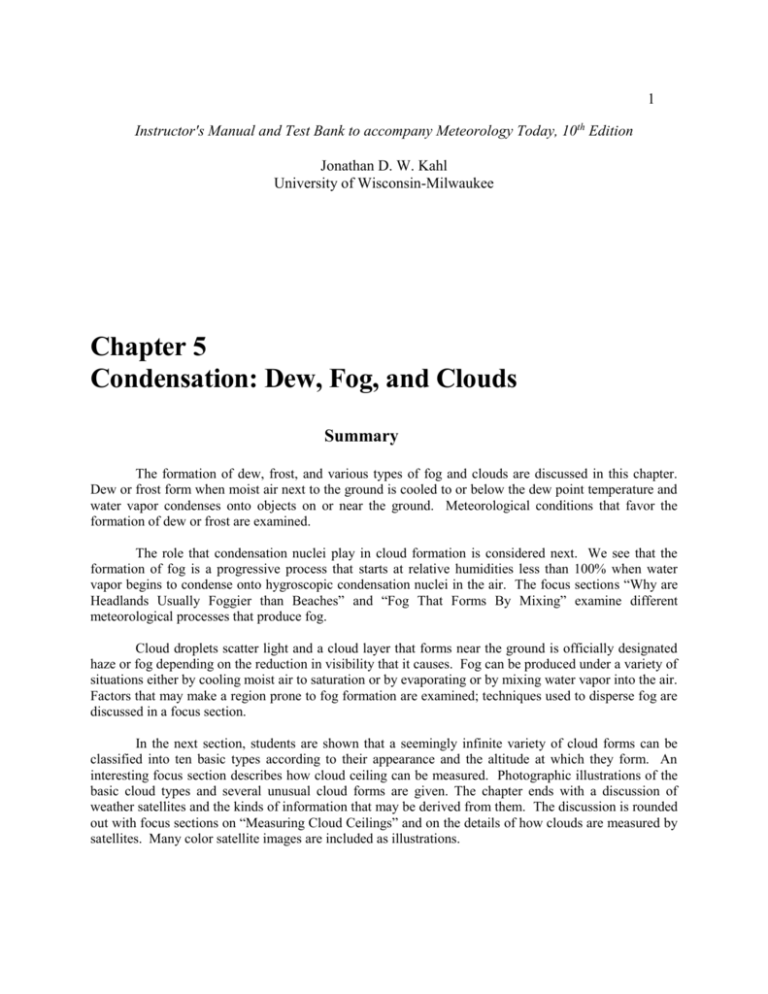
1 Instructor's Manual and Test Bank to accompany Meteorology Today, 10th Edition Jonathan D. W. Kahl University of Wisconsin-Milwaukee Chapter 5 Condensation: Dew, Fog, and Clouds Summary The formation of dew, frost, and various types of fog and clouds are discussed in this chapter. Dew or frost form when moist air next to the ground is cooled to or below the dew point temperature and water vapor condenses onto objects on or near the ground. Meteorological conditions that favor the formation of dew or frost are examined. The role that condensation nuclei play in cloud formation is considered next. We see that the formation of fog is a progressive process that starts at relative humidities less than 100% when water vapor begins to condense onto hygroscopic condensation nuclei in the air. The focus sections “Why are Headlands Usually Foggier than Beaches” and “Fog That Forms By Mixing” examine different meteorological processes that produce fog. Cloud droplets scatter light and a cloud layer that forms near the ground is officially designated haze or fog depending on the reduction in visibility that it causes. Fog can be produced under a variety of situations either by cooling moist air to saturation or by evaporating or by mixing water vapor into the air. Factors that may make a region prone to fog formation are examined; techniques used to disperse fog are discussed in a focus section. In the next section, students are shown that a seemingly infinite variety of cloud forms can be classified into ten basic types according to their appearance and the altitude at which they form. An interesting focus section describes how cloud ceiling can be measured. Photographic illustrations of the basic cloud types and several unusual cloud forms are given. The chapter ends with a discussion of weather satellites and the kinds of information that may be derived from them. The discussion is rounded out with focus sections on “Measuring Cloud Ceilings” and on the details of how clouds are measured by satellites. Many color satellite images are included as illustrations. 2 Teaching Suggestions 1. A dramatic demonstration of cloud formation in a bottle has been described by C.F. Bohren (Clouds in a Glass of Beer, pp. 8-14, John Wiley and Sons, New York, 1987). Place a small amount of water in a large bottle or flask. Close the top of the bottle with a rubber stopper. Connect a pump (an ordinary bicycle pump works well) to the bottle with a tube through a hole in the stopper. Pump air into the bottle. If the stopper has not been inserted too firmly, it will suddenly pop as air is being pumped into the bottle and will allow the air to expand outward and cool. A faint cloud should be visible in the bottle. Repeat the experiment, but this time add hygroscopic smoke particles by dropping a lighted match into the bottle prior to pressurization. This time a cloud will be much thicker and more clearly visible. The visibility is enhanced if a light source is placed behind the bottle so that the students are in a position to see light scattered in the forward direction by the cloud droplets. The cloud will disappear when the air in the bottle is pressurized. The compression warms the air and mixes in drier air from outside the bottle. This demonstration can be used to explain the formation of haze, fog, and clouds, as well as the role that condensation nuclei play in their development. The article by Bohren also includes a good demonstration of cloud droplet formation on grains of salt. 2. Dry ice offers a convenient way of producing thick clouds. Ask the students why a thicker cloud is formed when one blows on the piece of dry ice. Students should also understand why the cloud sinks. 3. Photos greatly enhance a discussion of clouds and cloud type identification. Show cloud images to illustrate the common cloud types and their characteristics. Then show additional images and ask the students to identify the cloud type. If possible, include cloud images from the local area. This will give the students some experience identifying clouds they are likely see at some point during the course. 4. Conduct a “Name that Cloud” competition during class. 5. Encourage students to photograph clouds. Establish a class Facebook page where students can post there photos with descriptions. View the posts during class. 6. Discuss the most common type(s) of fog that forms in your area. 7. Once students have begin to learn to identify clouds, ask the class “What type(s) of cloud(s) are present today?” at the beginning of each class. 8. Include a question “What type(s) of cloud(s) are present today?” on an exam. 9. Invite students to explain the reason for the cloud-free areas between cumulus clouds (subsidence). 10. Invite students to explain how cumulonimbus clouds are useful for visually identifying the tropopause. 3 Student Projects 1. During certain times of the year, students can observe the formation of dew, frost or fog. Have the students record weather data on these days as well as days on which dew, frost and fog did not form. 2. Is frost ever observed when the measured overnight minimum temperature remains above freezing? Is the layer of dew or frost thicker on some objects than other objects? Does the color or composition of the object have any effect on the formation of dew or frost? Is the formation of dew or frost thicker at ground level or on objects above ground level? A book by C.F. Bohren (ref: What Light Through Yonder Window Breaks, pp. 97-111, John Wiley and Sons, New York, 1991) contains an excellent discussion of how environmental factors affect the formation of dew and frost. Many of his experiments and observations could serve as student projects. 3. Students should be encouraged to observe and try to identify different types of clouds. Students could observe and record the sequence of different types of clouds that are associated with the approach and passage of a low pressure center or front. If they have sufficient means, students should be encouraged to photograph interesting cloud patterns and weather phenomena. 4. Using local landmarks, make a daily estimate of visibility. Determine whether visibility values are correlated with meteorological variables such as relative humidity. 5. Have students create a cloud climatology for the local area. The climatology could include the number of days on which different cloud types appear. Answers to Questions for Review 1. Dew: when the air cools to the dew point—the temperature at which saturation occurs. Frozen dew: If the air temperature should drop to freezing or below, the dew will freeze, becoming tiny beads of ice. Visible frost: forms on cold, clear, calm mornings when the dew-point temperature is at or below freezing. When the air temperature cools to the dew point (now called the frost point) and further cooling occurs, water vapor can change directly to ice without becoming a liquid first—a process called deposition. 2. Dry haze: forms when the relative humidity of the air is below the point where water vapor begins to condense on active hygroscopic nuclei. The floating particles remain small—usually no larger than about one-tenth of a micrometer. Wet haze: When the relative humidity reaches about 75 percent, condensation may begin on the most active hygroscopic nuclei. As water collects on the nuclei, their size increases and the haze particles, although still small, become large. Fog: As the relative humidity gradually approaches 100 percent, the haze particles grow larger, and condensation begins on the lessactive nuclei. 3. Because the pollution particles provide large numbers of hygroscopic nuclei on which water droplets can form. 4. Water vapor can condense onto hygroscopic nuclei particles at relative humidities less than 100 percent. 4 5. Acid fog: fog that forms in polluted air with gaseous impurities such as oxides of sulfur and nitrogen. Advection fog: Fog that forms when surface air is cooled to its saturation point by warm moist air moving over a cold surface. Radiation fog: Fog produced by the earth’s radiational cooling. Upslope fog: Fog that forms as moist air flows up along an elevated plain, hill, or mountain. 6. Sunlight penetrates the fog and warms the ground, causing the air temperature in contact with the ground to increase. The warm air rises and mixes with the foggy air above, which increases the temperature of the foggy air. In the slightly warmer air, some of the fog droplets evaporate, allowing more sunlight to reach the ground, which produces more heating, and soon the fog completely disappears. 7. It is a source of moisture to plants and animals; moderates temperatures in the California central valley. 8. Seeding of cold fog by injecting dry ice; increasing droplet size by injecting hygroscopic particles; warming the fog by burning fuel under it; using helicopters to mix the air. 9. As the earth cools by radiation, the temperature drops to the dew point temperature, causing saturation and the formation of a cloud (fog). 10. Warm, moist air blowing over a cool, dry surface. 11. When two unsaturated bodies of air mix and the resulting mixture is saturated. 12. High: cirrus, cirrostratus, cirrocumulus. Middle: altostratus, altocumulus. stratocumulus, nimbostratus. Vertical development: cumulus, cumulonimbus. Low: stratus, 13. Cirrus: thin, wispy, long streamers, feathery. Cirrocumulus: small puffs, grainy, sometimes form in rows. Cirrostratus: milky-white, cause optical effects. Altostratus: gray or blue-gray, sun dimly visible. Altocumulus: gray puffy masses, sometimes form in waves or bands. Stratus: uniform grayish cloud, covers entire sky, Stratocumulus: low lumpy clouds appearing in rows or patches, blue sky visible between clouds. Nimbostratus: grey, precipitating cloud, light or moderate precipitation. Cumulus: puffy cotton-ball appearance, white, blue sky between cloud elements. Cumulonimbus: thunderstorm cloud, over 10 km tall, dark, heavy precipitation, sometimes severe weather. 14. Because air at high altitudes is quite cold and dry. 15. The sun shines brightly through cirrostratus, but appears as a dull yellow disk with altostratus. 16. (a) cumulonimbus. (b) cumulonimbus. (c) altocumulus. (d) cirrus. (e) altostratus. (f) nimbostratus. (g) cumulonimbus. (h) cumulonimbus. 17. Because the open spaces between the clouds are less visible at a distance. 5 18. Geostationary satellites orbit the equator at the same rate the earth spins. Polar orbiting satellites pass over the north and south polar regions on each revolution. 19. (a) High clouds have colder temperatures than low clouds and thus look different on an infrared satellite image. (b) Thick clouds look whiter than thin clouds on a visible satellite image. 20. When temperature differences are small, it is difficult to directly identify significant cloud and surface features on an infrared picture. Certain temperature ranges in the infrared photograph are assigned specific shades of gray, or specific colors, to better identify different cloud types. 21. Nacreous clouds, noctilucent clouds. 22. Provide photographs of sparsely-populated areas, cloud movement, dissipation, development associated with weather fronts and storms, undistorted images in polar regions, vertical profiles of atmospheric temperature and moisture, cloud thickness. Answers to Questions for Thought 1. A cloud-free nighttime sky and a clearly visible moon indicate that the air is dry and that rapid radiational cooling will take place near the ground. 2. Icebergs chill the air in contact with them to below the dew-point temperature. 3. The sunglasses cool to the air temperature inside the motel room. Once you step outside, the temperature of the sunglasses is below the dew-point temperature of the humid outside air. The glasses cool the air in contact with them to the dew-point temperature, and moisture condenses onto them. 4. The windshield is quite cold. The car apparently travels into warmer air with a higher dew-point. The outside windshield cools the warmer air in contact with it to its dew-point temperature which is still below freezing and frost forms. 5. Really clean atmospheres would have no condensation nuclei so that clouds would not be able to form. Really dirty atmospheres are unhealthy. 6. In polluted air, condensation begins on hygroscopic particles when the relative humidity is less than 100 percent. Condensation removes water vapor from the air which lowers the dew-point temperature. This increases the spread between air temperature and dew-point temperature, and keeps the relative humidity at less than 100 percent. 7. Tropical waters are usually too warm to cool the air to its dew-point temperature. 8. The cold snow surface cooled relatively warm, moist air (moving in from the south) to its dewpoint temperature. 9. Fog droplets are so tiny that they settle very slowly. As long as the air remains saturated, fog is maintained as water vapor condenses onto nuclei forming new fog droplets. 6 10. Steam fog forms when cool air moves over a large body of warmer water. Due to the thermal properties of water, the water remains relatively warm during the autumn months. On the other hand, advection fog forms when warm, moist air moves over a colder surface. In spring the water of a large lake will warm more slowly and will remain colder than the adjacent land. 11. Latent heat of condensation is released as fog droplets form. Also, fog absorbs infrared energy radiated from the surface and re-radiates this energy back toward the surface. 12. The dew point decreased because water vapor was being removed from the air and transformed into liquid fog droplets. The dew point is a measure of the amount of water vapor in the air. 13. You see your breath because the warm, moist air from your mouth mixes with cooler air in the atmosphere. The mixture is saturated and condensation occurs with the exhaled breath. The air temperature does not have to be below freezing for this to occur. 14. The air temperatures aloft are much lower above polar latitudes than above subtropical latitudes. Altocumulus clouds usually contain liquid water. Over polar latitudes at 6400 m (21,000 feet), temperatures are generally low enough to freeze all liquid water. Therefore, the very cold air will produce a thin, ice crystal (cirriform) cloud. At 21,000 feet above the tropics and subtropics temperatures are not low enough to freeze all liquid water; consequently, thicker middle clouds may form at that altitude. 15. If the rain is light or moderate and steady, the cloud is most likely nimbostratus. If the rain falls in heavy showers, and lightning, thunder, or hail accompany it, then the cloud is probably cumulonimbus. (Careful: cumulus congestus may also produce heavy showers) 16. Cumulus fractus (or stratus fractus). Rain falling from the nimbostratus cloud evaporates, mixes, and saturates the air beneath it. If slight vertical motions exist, a cloud often forms. 17. Cumulus. Cumulus are individual-element clouds that can block the sun when passing overhead. After they pass by, the sun will again be visible. Answers to Critical Thinking Questions Figure 5.6. valley. There may have been more wind or warmer temperatures on the eastern side of the 7 Multiple Choice Exam Questions 1. Dew is most likely to form on a. clear, calm nights. b. cloudy, calm nights. c. clear, windy nights. d. cloudy, windy nights. e. rainy nights. ANSWER: A 2. The cooling of the ground to produce dew is mainly the result of a. conduction. b. radiational cooling. c. cooling due to the release of latent heat. d. advection. ANSWER: B 3. Particles that serve as surfaces on which water vapor may condense are called a. hydrophobic nuclei. b. nacreous nuclei. c. condensation nuclei. d. scud. ANSWER: C 4. Frost forms when a. objects on the ground cool below the dew point temperature. b. the dew point is 32F or below. c. water vapor changes into ice without first becoming a liquid. d. all of the above ANSWER: D 5. Frost typically forms on the inside of a windowpane (rather than the outside) because a. the inside of the pane is colder than the outside. b. there is more water vapor touching the inside of the pane. c. there is less water vapor touching the inside of the pane. ANSWER: B 6. Condensation nuclei may be a. particles of dust. b. nitric acid particles. c. smoke from forest fires. d. salt from the ocean. e. all of the above ANSWER: E 8 7. Condensation nuclei are important in the atmosphere because a. they provide most of the minerals found in water. b. they make it easier for condensation to occur in the atmosphere. c. they are the sole producers of smog. d. they filter out sunlight. e. they provide the only means we have of tracking wind motions. ANSWER: B 8. When radiation fog "burns off", the fog tends to dissipate a. from the bottom up. b. from the top down. c. starting at the middle and working both upward and downward. ANSWER: A 9. Radiation fog forms best on a a. clear winter night with a slight breeze. b. cloudy winter night with a strong breeze. c. clear summer night with a strong breeze. d. cloudy summer night with a slight breeze. e. cloudy winter night with a slight breeze. ANSWER: A 10. On a clear night, the minimum temperature drops to 34F. The following night, fog forms early in the evening. It is a good bet the minimum temperature will not be as low because of the a. enhancement of the greenhouse effect by the fog cloud. b. trapping of smoke and dust by the water vapor. c. calm winds that accompany fog. d. all of the above ANSWER: A 11. On a cold, winter morning, the most likely place for radiation fog to form is a. at the top of a hill or mountain. b. in a valley. c. along the side of a hill. d. over a body of water. ANSWER: B 12. The fog that forms along the Pacific coastline of North America is mainly which type? a. radiation fog b. upslope fog c. frontal fog d. advection fog e. steam fog ANSWER: D 9 13. If fog is forming at Denver, Colorado, and the wind is blowing from the east, then the fog is most likely a. advection fog. b. frontal fog. c. upslope fog. d. radiation fog. ANSWER: C 14. Exhaled breath from your mouth can condense when a. it is very cold. b. it is very warm and humid. c. the addition of water vapor from your breath causes the air's relative humidity to exceed 100 percent. d. all of the above ANSWER: D 15. Fog that most often forms as warm rain falls into a cold layer of surface air is called a. radiation fog. b. evaporation (mixing) fog. c. advection fog. d. upslope fog. ANSWER: B 16. Clouds are classified by their a. appearance. b. altitude. c. method of formation. d. all of the above e. altitude and method of formation. ANSWER: A 17. Fog is a major hazard to aviation. a. true b. false ANSWER: A 18. Which association below is NOT correct? a. cirrocumulus - high cloud b. cumulus - cloud of vertical extent c. altostratus - high cloud d. stratus - low cloud ANSWER: C 19. Even at high elevations where cirrus clouds are found, liquid water still exists in the clouds. 10 a. true b. false ANSWER: A 20. Which association below is not correct? a. cumulus congestus - anvil top b. cumulus - fair weather cumulus c. altocumulus castellanus - resemble "little castles" d. stratus fractus - scud e. cumulonimbus - thunderstorm clouds ANSWER: A 21. Which cloud is least likely to produce precipitation that reaches the ground? a. stratus b. nimbostratus c. cumulonimbus d. cirrocumulus ANSWER: D 22. Which cloud type is composed of ice crystals and can cause a halo to form around the sun or moon? a. altostratus b. stratus c. nimbostratus d. cirrostratus e. angelitus ANSWER: D 23. Which of the following associations is not correct? a. altostratus - middle cloud b. cirrus - high cloud c. stratocumulus - cloud of vertical development d. cirrocumulus - high cloud e. cumulonimbus - cloud of vertical development ANSWER: C 24. Light or moderate-but-steady precipitation is most often associated with ____ clouds. a. nimbostratus b. cirrostratus c. cirrocumulus d. cumulonimbus ANSWER: A 25. Which of the following pairs of cloud types could be very similar in appearance? a. cumulus and cirrus 11 b. cirrostratus and stratus c. altocumulus and cirrocumulus d. cirrocumulus and cumulonimbus ANSWER: C 26. When viewed from the surface, the smallest individual cloud elements (puffs) are observed with which cloud? a. stratocumulus b. cumulus c. cirrocumulus d. altocumulus e. cumulonimbus ANSWER: C 27. Cirrus clouds are composed primarily of a. water droplets. b. water vapor. c. ice particles. d. salt aerosols. ANSWER: C 28. Detached clouds of delicate and fibrous appearance, without shading, usually white in color and sometimes of a silky appearance are a. stratus. b. cirrocumulus. c. altostratus. d. cirrus. ANSWER: D 29. Suppose the sky is completely covered with a thin, white layered-type cloud. You look at the ground and see that objects cast a distinct shadow. From this you conclude that the cloud type must be a. stratus. b. nimbostratus. c. cirrostratus. d. stratocumulus. ANSWER: C 30. A dim, "watery" sun visible through a gray sheet-like cloud layer is often a good indication of ____ clouds. a. stratocumulus b. cirrostratus c. cumulonimbus d. altostratus e. nimbostratus ANSWER: D 12 31. An anvil-shaped top is most often associated with a. cumulonimbus. b. cumulus congestus. c. altocumulus. d. cumulus humilis. ANSWER: A 32. A low, lumpy cloud layer that appears in rows, patches, or rounded masses would be classified a. nimbostratus. b. stratus. c. altocumulus. d. stratocumulus. ANSWER: D 33. Hail is usually associated with what cloud? a. stratus b. cumulus c. stratocumulus d. altocumulus e. cumulonimbus ANSWER: E 34. The cloud with the greatest vertical growth is a. cumulus congestus. b. cumulus humilis. c. cumulonimbus. d. cirrocumulus. ANSWER: C 35. As Apollo 12 ascended into the atmosphere, the height of the surrounding clouds was noted to be 42,000 feet. A lightning stroke was seen within these clouds, indicating that they must have been a. cumulus congestus. b. cumulonimbus. c. cirrus. d. cirrocumulus. e. lenticular. ANSWER: B 36. Which cloud forms in descending air? a. cumulus fractus b. cumulonimbus c. mammatus d. pileus ANSWER: C 13 37. Which below is NOT a way in which a contrail may form? a. from water vapor in the engine exhaust mixing with air b. by air cooling as it passes over the aircraft's wings c. due to heating of the air by the engine exhaust d. all of the above ANSWER: C 38. When clouds are viewed near the horizon, the individual cloud elements usually a. appear closer together than is actually the case. b. appear farther apart than is actually the case. c. appear lighter in color than is actually the case. d. appear to have more vertical development than is actually the case. ANSWER: A 39. If a pilot balloon rises at a rate of 100 m per minute, and if it disappears into a deck of stratus clouds 1,500 m (5,000 ft) thick in 5 minutes, what is the ceiling of the cloud layer? a. 100 m (300 ft) b. 300 m (1,000 ft) c. 500 m (1,600 ft) d. 1,500 m (5,000 ft) e. 2,000 m (6,400 ft) ANSWER: C 40. Infrared satellite images are computer enhanced to a. increase the contrast between specific features in the picture. b. show where thick clouds with cold tops are located. c. show where clouds with tops near the freezing level are located. d. all of the above ANSWER: D 41. Satellite images taken of clouds at night use a. reflected visible light. b. reflected infrared light. c. emitted infrared light. d. microwave radiation. ANSWER: C 42. Satellites can a. monitor the amount of snow cover. b. provide information about the earth-atmosphere energy balance. c. provide information about surface water temperatures. d. monitor the movement of icebergs. e. all of the above ANSWER: E 14 43. When temperatures are below freezing, the temperature to which air must be cooled in order for a phase change to occur is called the a. wet bulb. b. dew point. c. frost point. d. heat index. ANSWER: C 44. Radiation fog typically forms on a. clear, calm days. b. clear, windy days. c. clear, calm nights. d. clear, windy nights. ANSWER: C 45. In hilly areas, cold air typically collects a. on hilltops. b. in valleys. ANSWER: B 46. Advection fog is often observed along the Pacific coast during summer, as westerly winds carry moist air toward the shore. The fog forms because the surface water near the coast is ____ the surface water farther offshore. a. much colder than b. much warmer than c. the same temperature as ANSWER: A 47. Suppose two ocean currents with different temperatures are flowing next to one another. If the wind blows perpendicular to the currents, we would expect to find a. radiation fog. b. steam fog. c. lenticular clouds. d. advection fog. ANSWER: D 48. Upslope fog forms because air ____ as it flows up a hill or mountain range. a. warms adiabatically b. warms radiatively c. cools adiabatically d. cools radiatively ANSWER: C 15 49. Suppose two unsaturated air masses mix horizontally. The resulting mixture cannot possibly be saturated. a. true b. false ANSWER: B 50. Which two clouds can produce precipitation? a. cumulonimbus, stratocumulus b. nimbostratus, altostratus c. nimbostratus, cirrus d. cumulonimbus, nimbostratus ANSWER: D Essay Exam Questions 1. It is a cold winter night and a fog cloud forms. If it continues to cool during the night would you expect to find that the dew point has changed overnight? If so, would you expect to find that dew point has increased or decreased? 2. List the main types of fog, then briefly explain how each one forms. Where might you expect each of these different types of fog to form? 3. List one or more key identifying features for each of the ten basic cloud types. Which cloud types might have fairly similar appearances and thus be difficult to identify? 4. With which cloud type would each of the following phenomena be associated? lightning hail tornadoes brief heavy rain steady rain milky sun halo mackerel sky 5. Suppose the sky is covered with stratus clouds. How might you determine whether middle or high clouds are also present? 6. A vertically-viewing detector is located 8,000 feet from a rotating beam ceilometer. Determine the height of the cloud base assuming a signal is detected when the ceilometer beam elevation angle is 30o. 7. List the major height categories of clouds. What differences might you expect to find in the clouds that form at these different levels? 8. Fog is often described as a cloud that forms at ground level. In what ways are the formation of fog and clouds similar and different? 9. Explain why clouds form in rising air. 10. Would it be possible for rising air to remain cloud-free? If not, why not? If so, how? 16 11. Describe, with the aid of a figure, the orbital paths followed by geostationary and polar-orbiting satellites. 12. What kinds of information about clouds could you hope to determine using infrared and visible satellite photographs? 13. List and discuss some of the effects that you think weather satellites may have had on the field of weather prediction. 14. Under what conditions can a cloud form when air is sinking? 15. How can you visually distinguish between cumulus, altocumulus and cirrocumulus clouds?

